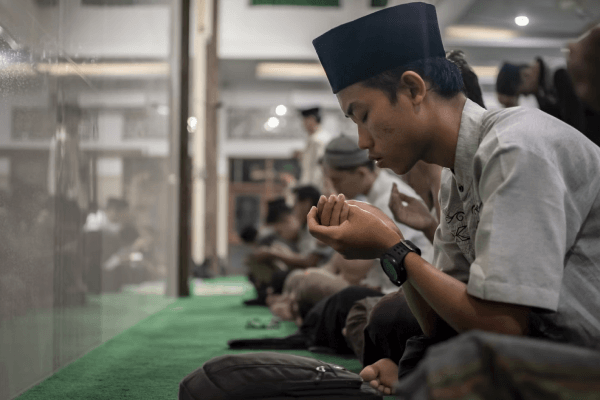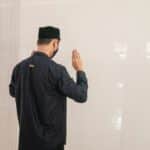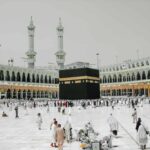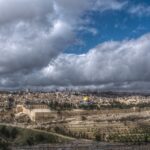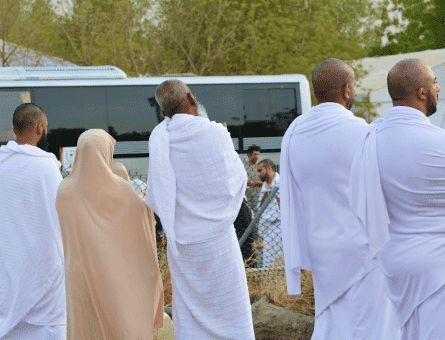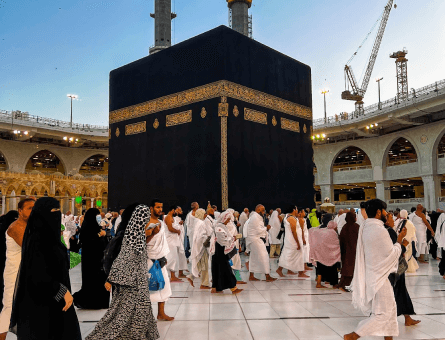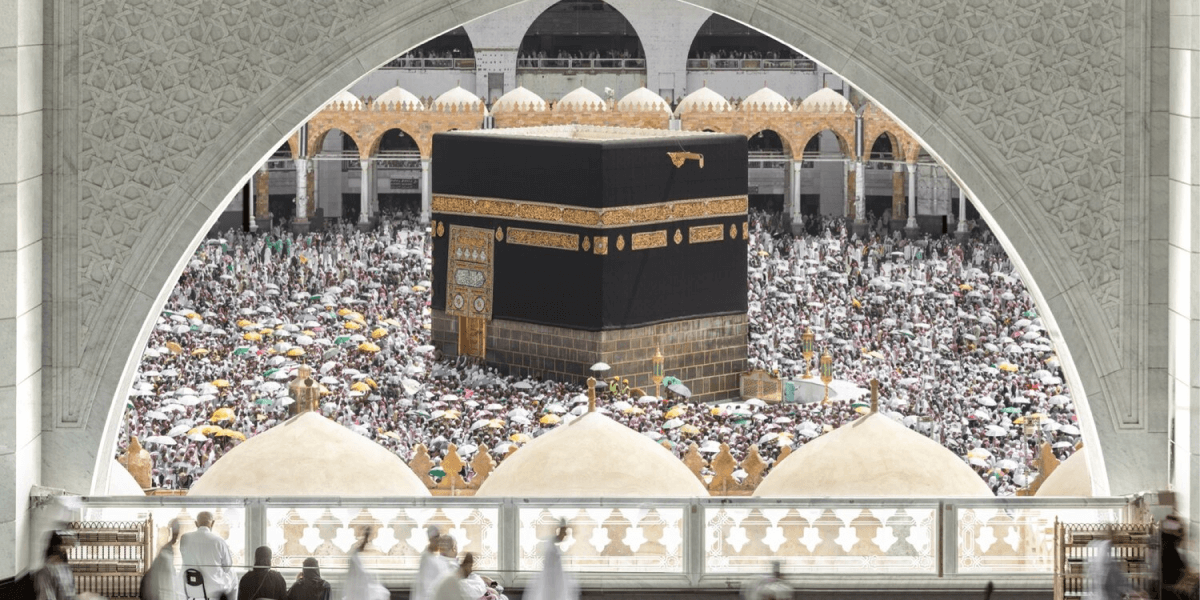Holy Kaaba – Everything you need to know
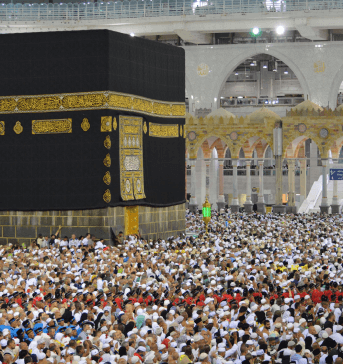 Located in the western part of Saudi Arabia, in the province of Hejaz, not far away from the Red Sea, lies in the epicenter of Mecca, one of the most holy Islamic sites, the Holy Kaaba, the House of Allah SWT. Constructed from bricks, the Kaaba is 60 feet in height, 60 feet wide and 60 feet long.
Located in the western part of Saudi Arabia, in the province of Hejaz, not far away from the Red Sea, lies in the epicenter of Mecca, one of the most holy Islamic sites, the Holy Kaaba, the House of Allah SWT. Constructed from bricks, the Kaaba is 60 feet in height, 60 feet wide and 60 feet long.
The stone-built house and city of Mecca have been known by world travellers since time immemorial. Also known as Baitullah, Bait-al-Haram (the Sacred House) and Bait-al-Atiq (the Ancient House), the Holy Kaaba has a rich history that predates Islam itself.
According to tradition, Allah SWT commanded that the Holy Kaaba be built in the shape of the House in Heaven known as Baitul Ma’amoor. In his boundless Mercy, Allah SWT established a similar location on Earth. Here is everything you need to know about the Kaaba, the house of Allah SWT.
What Is the Kaaba?
There is no place on Earth as holy and as venerated as the Holy Kaaba. The religion of Islam, the faith of approximately 1.8 billion people, dictates each Muslim to pray five times a day in the direction of the Kaaba, located in the centre of Mecca, Saudi Arabia.
The word “Kaaba” is derived from the Arabic word “Ka’b” which literally means “cube.” Wrapped in a black and gold embroidered cotton veil and silk, the Holy Kaaba is roughly 15 metres high (50 feet) and about 10 by 14 metres (35 by 40 feet) at its base.
Built using marble and gray stone, the House of Allah SWT is located within Masjid Al Haram (the Great Mosque of Mecca). The Holy Kaaba is oriented in such a way that its corners roughly correspond to the direction of the compass.
Baitullah is considered by Muslims worldwide as the most sacred spot on Earth. Every year, millions of Muslims visit the Holy Kaaba to perform Umrah and the annual pilgrimage of Hajj.
When Was the Kaaba Built?
Initially, the Holy Kaaba was built during pre-Islamic times on the command of Allah SWT, by Prophet Ibrahim (AS) and Prophet Ismail (AS) after they returned to Mecca.
“And (remember) when Abraham and (his son) Ishmael were raising the foundations of the House (the Kaba at Mecca), (saying), ‘Our Lord! Accept (this service) from us. Verily, You are the All-Hearer, the All-Knower.’” (Holy Quran 2:127)
At the time, the Holy Kaaba was a simple rectangular structure with no roof, four walls and two entrances on the eastern and western walls. This was when Angel Jibrail (AS) brought to Earth Hajr-e-Aswad (Black Stone), the stone from Heaven.
Prophet Ibrahim (AS) along with Prophet Ismail (AS) placed the stone in the House of Allah SWT. Throughout the years, the descendants of Prophet Ismail (AS) were named custodians of the Holy Kaaba.
In 608 CE, the powerful Quraysh tribal chiefs collaborated to rebuild the Kaaba using various types of wood and brick. The Kaaba was earlier built on active floodplains because of which it remained underwater most of the time.
Therefore, the Quraysh leaders decided to heighten the entryway to the sacred site to protect it from attackers and floodwaters. However, after the conquest of Mecca, Prophet Muhammad (PBUH) re-entered the Holy Kaaba and purified it by breaking all the idols.
The Kaaba has been renovated extensively over the years. Even though the structure has been upgraded to accommodate an increasing number of pilgrims, the foundation of the House of Allah SWT remains the same. Currently, the Holy Kaaba is also home to some of the most important Islamic landmarks including Maqam e Ibrahim, Musallah Jibraeel and Hajr e Aswad.
How Old Is the Kaaba?
According to Islamic history, it is believed that the Holy Kaaba was constructed by Prophet Ibrahim (AS) over 5000 years ago. Throughout the history of Mecca, the doors of the holy Kaaba and surrounding land have been of interest to rulers and kings.
Who Built the Kaaba and Why?
The Holy Kaaba has been in place even before the arrival of Islam. It is known as one of the most sacred places to worship in the world. According to tradition, it was Prophet Ibrahim (AS) and Prophet Ismail (AS) who constructed the Holy Kaaba at the command of the Almighty. Allah SWT says in the Holy Quran:
“And (remember) when Abraham and (his son) Ishmael were raising the foundations of the House (the Kaaba at Mecca), (saying), ‘Our Lord! Accept (this service) from us. Verily, You are the All-Hearer, the All-Knower.’” (Holy Quran, 2:127)
“And [mention, O Muhammad], when We designated for Abraham the site of the House, [saying], “Do not associate anything with Me and purify My House for those who perform Tawaf and those who stand [in prayer] and those who bow and prostrate.” (Holy Quran, 22:26)
“And [mention] when We made the House a place of return for the people and [a place of] security. And take, [O believers], from the standing place of Abraham a place of prayer. And We charged Abraham and Ishmael, [saying], “Purify My House for those who perform Tawaf and those who are staying [there] for worship and those who bow and prostrate [in prayer].” (Holy Quran, 2:125)
Kaaba History
Did you know that the centre of the religion of Islam, the Holy Kaaba, used to be a sanctuary for idol worshipers? According to Islamic history, the Holy Kaaba was constructed by Prophet Ibrahim (AS) and his son, Prophet Ismail (AS). It is believed that during pre-Islamic times, the Holy Kaaba stood as an unroofed structure comprising two entrance pathways, four walls and no windows.
However, in 608 CE, because of its religious value to the idol worshippers, the then-rulers of Mecca, the Quraysh tribe decided to reconstruct the Holy Kaaba with wood and masonry. During the renovation, the door of the Holy Kaaba was raised above ground level to protect it from floodwaters and intruders.
In 620 CE, after facing brutal persecutions of the Quraysh, Prophet Muhammad (PBUH) and his fellow companions migrated from Mecca to Madinah (formerly known as Yathrib). After the conquest of Mecca and upon his return in 630 CE, on the command of Allah SWT, Prophet Muhammad (PBUH) declared the Holy Kaaba as the focal point of Muslim worship and pilgrimage.
He cleansed the sacred house of Allah SWT by destroying all the pagan gods and performing Tawaf around it, returning the holiness of the Kaaba to the monotheism of Prophet Ibrahim (AS). While doing so, the beloved Messenger (PBUH) of Allah SWT kept reciting the following verse: “Truth hath come and falsehood hath vanished.” (Holy Quran, 17:81)
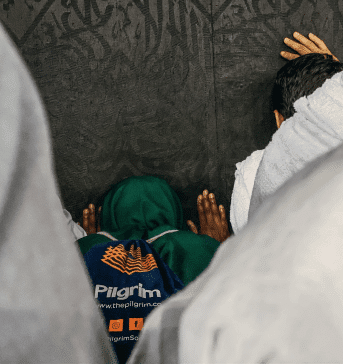 The Holy Kaaba is home to Hajr-e-Aswad (the Black Stone), which archangel Jibrail (AS) gave to Prophet Ibrahim (AS) during the construction of the House of Allah SWT. Hajr-e-Aswad is revered by Muslims worldwide and it is a part of the rituals of Hajj to perform Istilam of the Black Stone.
The Holy Kaaba is home to Hajr-e-Aswad (the Black Stone), which archangel Jibrail (AS) gave to Prophet Ibrahim (AS) during the construction of the House of Allah SWT. Hajr-e-Aswad is revered by Muslims worldwide and it is a part of the rituals of Hajj to perform Istilam of the Black Stone.
The Kaaba has been rebuilt multiple times since Prophet Muhammad’s (PBUH) death. During the first siege of Mecca in 683 CE, it was severely destroyed by fire during the fight between Abdullah ibn al-Zubayr (RA) and the Umayyads. The Kaaba was reconstructed by Abdullah to accommodate the Hateem.
The second siege of Mecca took place in 692 CE, during which the Kaaba was pelted with stones. The following year, Abd al-Malik demolished the Kaaba’s ruins and reconstructed it in cubical configuration, as it had been during the Prophet’s (PBUH) time. Later in history, the walls of the Kaaba collapsed due to a flood in 1626, after which Masjid Al-Haram (The Great Mosque) underwent repairs and the Kaaba was rebuilt using granite stones. The structure of the Holy Kaaba has been the same since then.
“Indeed, the first House [of worship] established for mankind was that at Mecca – blessed and a guidance for the worlds.” (Holy Quran, 5:95)
How Did the Kaaba Come to Be a Holy Site for Muslims?
Abdullah bin Umar (RA) narrated, “The Prophet Muhammad (PBUH) arrived (at Mecca) in the year of the Conquest (of Mecca) while Usama was riding behind him on (his she-camel). Al-Qaswa, Bilal and Uthman bin Talha were accompanying him. When he made his she-camel kneel down near the Kaaba, he said to Usman, “Get us the key (of the Kaaba).”
He brought the key to him and opened the gate (of the Kaaba) for him. The Prophet (PBUH), Usama, Bilal and Uthman (bin Talha) entered the Kaaba and then closed the gate behind them (from inside). The Prophet Muhammad (PBUH) stayed there for a long period and then came out. The people rushed to get in, but I (Ibn Umar) went in before them and found Bilal standing behind the gate, and I said to him, “Where did the Prophet Muhammad (PBUH) pray?”
He said, “He prayed between those two front pillars.” The Kaaba was built on six pillars, arranged in two rows, and he prayed between the two pillars of the front row, leaving the gate of the Kaaba at his back and facing (in prayer) the wall which faces one when one enters the Kaaba. Between him and that wall (was the distance of about three cubits). But I forgot to ask Bilal about the number of rakaat the Prophet (S.A.W.) had prayed. There was a red piece of marble at the place where he (i.e. the Prophet (PBUH)) had offered the prayer.” (Sahih Bukhari)
Why Is the Kaaba Important?
It is important to remember that Muslims do not worship the Holy Kaaba. However, it is a sign of Allah’s SWT. The Kaaba symbolizes Allah’s SWT Oneness, which is also the first and most fundamental pillar of Islam, that there is no god but Allah SWT. Muslims all around the world are obedient slaves of Allah SWT.
In Islam, the significance of the Holy Kaaba can be understood by the fact that Muslims all around the world face the Qibla (Holy Kaaba) while performing Salah (prayer), which is Islam’s second pillar. As a result, it serves as a focal point for Muslim unity.
Hajj (Pilgrimage) is the fifth pillar of Islam. Every Muslim is expected to offer Hajj at least once in their lives. This pilgrimage is organized around the Holy Kaaba. Pilgrims come to Mecca and gather in Haram Sharif to perform Tawaf around the Holy Kaaba. Muslims from all around the world come together to surrender to Allah’s SWT will. In Islam, the Holy Kaaba is a symbol of unity.
The significance of the Holy Kaaba is proven in the following verses of the Holy Quran:
“Allah SWT has made the Kaaba, the Sacred House, standing for the people and [has sanctified] the sacred months and the sacrificial animals and the garlands [by which they are identified]. That is so you may know that Allah SWT knows what is in the heavens and what is in the earth and that Allah SWT is Knowing of all things.” (Holy Quran, 5:97)
“God has appointed the Kaaba, the Sacred House, support for mankind, and the Sacred Month and the offerings and the garlands. That is so that you may know that God knows whatsoever is in the heavens and whatsoever is in the earth, and that God is Knower of all things.” (Holy Quran, 5:97)
Why Do Muslims Pray Towards the Kaaba?
According to the history of Islam, Prophet Muhammad (PBUH) was gifted Prophethood along with the first revelation of the Holy Quran in 610 CE through Angel Jibrail (AS). During the initial years of Prophethood, Prophet Muhammad (PBUH) along with his companions used to face Masjid Al-Aqsa in Jerusalem while praying Salah.
However, about a year and a half after migrating to Madinah, Prophet Muhammad (PBUH) redirected the Muslims to face the Holy Kaaba as it was the order of Allah SWT. Therefore, Muslims today pray in the direction of the Holy Kaaba in the Grand Mosque, simply because it is the command of the Almighty, the one we worship, Allah SWT.
“Verily, We have seen the turning of your (Muhammad’s (PBUH)) face towards the heaven. Surely, We shall turn you to a Qiblah (prayer direction) that shall please you, so turn your face in the direction of Masjid al-Haram. And wheresoever you people are, turn your faces (in prayer) in that direction.” (Holy Quran, 2:144)
Can Non-Muslims Go to Medina?
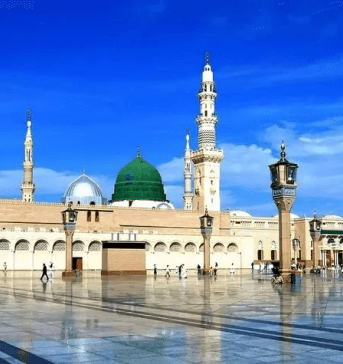
Yes, even though non-Muslims are allowed to visit Medina, they are not allowed to enter the premises of Masjid al-Nabawi, the Mosque of Prophet Muhammad (PBUH).
Summary – Kaaba
The history of the Holy Kaaba isn’t just an interesting snippet from the past. The holy structure is real, present and is marked as the Qiblah, or the centre of prayer that connects all Muslims. Every year, millions of Muslims worldwide gather in Masjid Al-Haram (also known as the Great Mosque) to perform pilgrimage (Hajj and Umrah) to seek the forgiveness and blessings of Allah SWT.
Dressed in white-coloured clothing known as Ihram and performing Tawaf around the Holy Kaaba, this act of worship reminds us that we all are equal in the eyes of Our Creator, and to Him we shall all ultimately return. To sum it all up, the Holy Kaaba is a symbol of unity and hope that Muslims need to revive and strengthen their faith when worldly desires try to break them down.
Through His Names
New course with
Ustadh Shabbir Hassan




